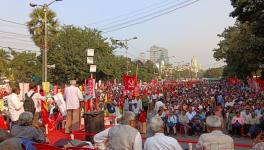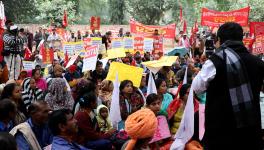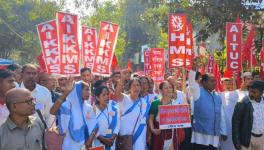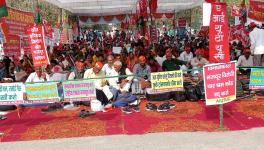Padmavati and Protesting Peasants: Products of the Same Agrarian Crisis
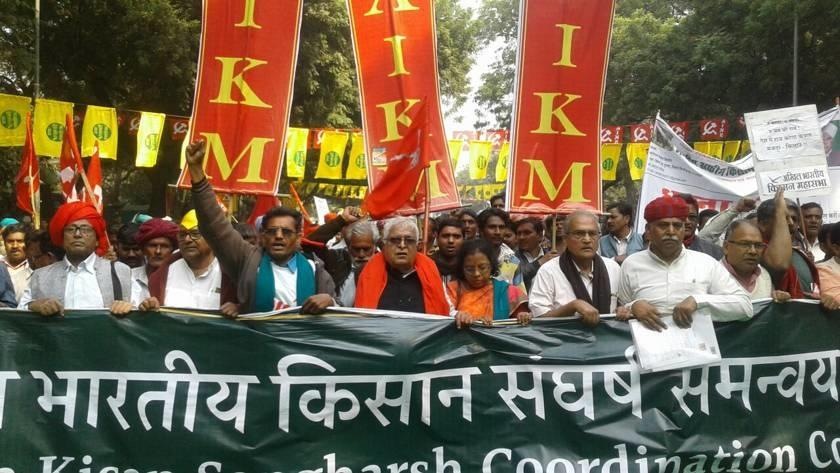
Was the ‘Padmavati debate’ a creation of the corporate media to overshadow the major farmer’s rally that hit the streets of Delhi a few days back? More than 3,00,000 peasants from all across the country marched on the streets of Delhi against the deepening agrarian distress, accumulating debts of the peasants, land alienation and lack of systemic support from the state and central governments in determining the basic market price of major food crops. There was hardly any media coverage of this Kisan rally. The media instead gave disproportionate screen time on the entire chaos created by the ’fringe group’ called Karni Sena, the brazen threats of beheading and mutilation, the brandishing of swords to save the honour of a fictitious woman who may or may not have existed in the 13th century.
However, I believe creating a binary between Padmavati and the protesting peasants obfuscates a far more complex story. Rather, both are on two ends of the same spectrum. The Peasants and Padmavati are in fact intrinsically connected. Both stem out of the same situation of deepening agrarian crisis. This cataclysmic condition of agriculture is indeed devastating the lives and livelihoods of small and marginal peasants by pushing them to the brink of existence or resulting in massive rates of suicides by them. However, it is also affecting the rich peasants and liquidating the power and authority of certain dominant caste groups who hitherto wielded their power through the appropriation of the primary means of production -- land.
The Karni Sena, whom the media ridiculed as ‘fringe’ is constituted and represented by the entrenched feudal leadership of the Rajput community. They are backed by the ruling BJP, patronised by other opposition parties and given complete impunity by the state in verbal as well as physical acts of violence. They represent the stagnant section of the community which is desperate to reinvent and reinvigorate their diminishing feudal valour, in the face of this agrarian crisis. They bargain with the ruling classes to safeguard their privileges and honour. Their acts of crass hooliganism can also be construed as an assertion of identity which is in distress.
However, through this assertion, they want to forge a vertical unity within the Rajput community, as opposed to the horizontal solidarity of class alliance that the peasant movement is trying to build around the category of kisan. The ruling class is deliberately patronising and promoting the Karni Sena (and its counterparts within other communities) in opposition to the progressive consolidation of the peasants.
So as much as the liberal and neo-liberal sections of the society want to wish the Karni Sena away, want them to be incarcerated and banned, deny them airtime on the prime media channels, none of that is going to happen. Three Chief Ministers have already declared their open support to Karni Sena. The Central government is calculatedly silent. One of the CMs Shivraj Singh Chauhan fired bullets on the protesting peasants of Mandsaur just a few months back. The other one, Yogi Adityanath sent the peasants of his state a ridiculous ‘loan waiver’ of 70 paise, that was printed on a paper whose print cost would be more than Rs. 7. Their allegiances are more than clear.
The Karni Sena, after all, is one of the strongest allies of the ruling regime in Rajasthan right now. The corporate media too routinely gives them space (although condemning them at the same time). That is not just because they provide comic relief and sensational news, but also because the corporate media recognizes the legitimate presence of Karni Sena as a venerable stakeholder of the Indian society. They know this fringe after all is not really a fringe. Just a year back the same media called Yogi Adityanath a fringe as well, but now they don’t hide their sycophancy for this leader and new poster boy of Hindutva.
Coming back to Karni Sena, how do they execute the caste consolidation and solidification of their diminishing feudal glory? One of the main planks is always by creating a frenzy around women’s honour. In this case, it was the honour of Rani Padmavati, who may or may not have existed in the 13th century. I find it really absurd and bizarre when the left, liberals and even neo-liberals tried to argue with Karni Sena with facts and even logic. By bombarding them with facts, disputed facts, historical anecdotes or the real content of the film and thereby trying to project them as ‘ignorant fools’, may have generated a few laughs in the urban drawing rooms, but the main point was missed.
Karni Sena gives two hoots about history or frankly even Rani Padmavati. They have already mellowed down their protest around the film that is after all produced by Viacom 18, a Company owned by Mukesh Ambani. They will ultimately settle for few cuts or even monetary compensation. Trying to reason with them with the real history is a ridiculously futile venture. Using Padmavati as an excuse, their real attempt was to assert themselves as a formidable force and they have successfully done that. They have also foregrounded their misogynist notion about women’s honour and that it is legitimate for sword-wielding moustached men to protect the honour of a woman posthumously after she may or may not have killed herself in a pyre in the 13th century.
When did the Karni Sena wield swords to protect caste honour in the recent past? Well not so long ago. It’s not much talked about in the media, but the massive atrocities on Dalits in Saharanpur was led by one Sher Singh Rana, who is a leader of the same Karni Sena. According to some media reports, he was also the one who declared the first blueprint for the Padmavati protests from a public platform. Just for further information, Mr Rana was released on bail in 2016 after ten years of incarceration, as he was one of the murderers of Phulan Devi. His extremely active political life thereafter, which involves a lot of sword-wielding, leading carnage and burning Dalit households, vandalising film shoots and issuing death threats, could not have materialised without extensive impunity and state patronage. The fringe is not so fringe after all.
And if one remembers, the attack on Saharanpur started with the celebration of Maharana Pratap’s birthday! Now does the historical veracity of the day, when exactly Rana Pratap used to cut the cake, really matter? It was an invented occasion for the Rajputs to attack the Dalits, who are now asserting for upward social mobility and more importantly for their dignity. The Rajputs feel threatened to see the Dalit youth learn English in the Bhim Army tutorial homes and look them back eye to eye! What will be left of the great Rajput, when the land that was the source of their power and prosperity yields nothing; when the chamars, whom they have treated as animals start to learn English and even dare to put up boards in Ghrkauli village saying ‘The Great Chamar welcomes you’! What will be left of the Rajput if their women are not ready to throw themselves in pyres for the sake of honour anymore? There are two options. You oil your rusted swords and your moustaches, remind the women of the glory of their golden cage of honour and force them into it. Set fire to the houses of the Dalits to devastate the little painstaking progress they have made over generations. Dig Rana Pratap and Padmavati from the grave of history and folklore and create opportunities to refurbish your waning feudal valour.
Or else one could forget the relics of history, and start marching towards Delhi, unitedly across caste and gender, and demand resolution to the deepening agrarian crisis. One can build up a movement against intensifying agrarian distress because after all, it is the massive criminal negligence of the state and the penetrating finance capital within agriculture that is responsible for the catastrophe. This crisis is not the making of the peasants themselves and no ghosts of Rani Padmavati or Rana Pratap can save them from that. On their way, they could join ranks with the peasants marching from Tamil Nadu and Madhya Pradesh, from Vidarbha and Bundelkhand and so on. And that is why Padmavati and the peasants lie on the two ends of the same spectrum.
The situation is not unique for the Rajputs alone. For all the landed castes, a section of whom had been extremely dominant; the same story is running everywhere. The Marathas, the Jats, the Patidars are all going through the same agrarian distress and loss of glory. Each one of them is now desperately demanding reservation, although all of them have violent histories of opposing caste based reservation for the SC/ST and even OBC. The state is desperately trying to contain their distress by encouraging the feudal section to run amok and by ordering multi-crore worth Made in China statues of their icons.
To conclude I would say, the problem is deeper than just the TV room conspiracy of creating one issue to black out another. Suhel Seth the celebrated ‘socialite’ and corporate lobbyist, lambasted a Karni Sena leader on NDTV, abused him and proclaimed ‘They represent an India that we should have left long back’. But then Seth is being delusional and probably willfully so. Because in Modi’s New India, Karni Sena and the likes are going to be the mainstream. Or at least that is what the ruling regime is going to push for. Moreover, it is the same neo-liberal capital that Seth and his ilk represent that has precipitated the agrarian crisis and Karni Sena is an outcome of the same. And frankly speaking, if asked to take a side between sword-wielding Karni Sena or the barefooted peasants who stormed the capital challenging the agrarian distress, Suhel Seth or the howling media anchors, their belligerence notwithstanding, will any day settle for the former.
Disclaimer: The views expressed here are the author's personal views, and do not necessarily represent the views of Newsclick.
Get the latest reports & analysis with people's perspective on Protests, movements & deep analytical videos, discussions of the current affairs in your Telegram app. Subscribe to NewsClick's Telegram channel & get Real-Time updates on stories, as they get published on our website.










